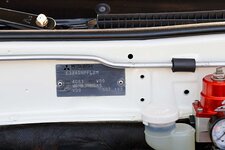After much time, money and effort, I finally got the car to the point where I felt like I could really push the 68HTA V2. My intention all along was to see what this turbo was really capable of, and I think I'm satisfied with the answer I got. I'll say a few things up front about this turbo:
First, I'll concede this turbo is on the laggy side. In spite of my best efforts, I was unable to get this to spool like it's TD05H predecessors. Now, that's not to say there's not room for improvement, because there certainly is. If spool was your overall goal, you could probably tailor your build to suit this turbo's characteristics a bit more than I have, and get better low end response. However, I've said it before and I'll say it again: This is not a 16G, so don't expect it to perform like one. Also, if you wanted to do the work and machine a 7cm turbine housing for this, I'd bet you'd see a decent improvement on the low end, but you'll certainly pay for that in peak flow. That all being said, the spool isn't horrible considering the amount of air it moves up top.
Second, if you want to get real performance out of this turbo, you need to ditch the internal gate. I started with the stock type actuator that comes with the turbo from FP. It's shimmed to death right out of the box:
With the WGA setup above, I was only able to get about 30 PSI peak boost, which would fall off at redline (8k) to around ~25ish PSI. This is obviously bad for power up top, which is where you want gains out of this turbo over the TD05H units. I'm running ECMlink boost control, and maxed my duty cycle out across the board to get the boost numbers mentioned above.
So, I swapped to a modified Holset WG actuator in hopes that it would allow me to hold more boost up top. I even shimmed the sh*t out of it in hopes it would hold better. Although it did help a little, it only increased my ability to hold boost by a few pounds. I saw around 32 PSI peak, and could hold just over 26 PSI to redline after installing the Holset WGA. I'm running a good sized stainless tubular O2 housing, and have 3" cat back exhaust. Again also, my EBC was maxed out at 100% DC.
Bottom line, the internally gated turbine housing just creates too much back pressure to hold boost to redline. At least, that's my experience. If you are going for records on this turbo, it certainly won't be on the internally gated turbine housing...I'm certain of that.
After doing everything in my power to maximize boost, I figured it was time to hit the dyno and see what this 68HTA was capable of.
So, I hit up Dave at EFI Specialties & Performance to schedule some dyno time. All the tuning was done by me, but Dave was kind enough to lend me his dyno and Friday evening so I could put my shitbox on his rollers and play with the tune. It was awesome meeting Dave. He did an outstanding and professional job with the car on the dyno.
On the dyno, I only tweaked the SD table between pulls; boost and timing remained the same for all 3 runs. With each pull I saw a small power increase after tweaking the tune. With more pulls, I probably could have squeezed out a bit more power, but it really wasn't worth the time or effort at that point. Dave and I came to the general consensus that my turbo is damn near tapped out anyways, so there was no use in going for records. Logs seemed to agree, as they showed slightly over 51lbs/min, which would have been higher if the car would hold 30 PSI to redline. A log of the best run is attached below.
Dyno run log
Laggy or not, bang for buck it's hard to beat the 68HTA V2, IMO. I picked this turbo up brand new for around $600 bucks shipped to my door, and it's a good performer for a stock appearing bolt-on unit. Sure, there are better turbos out there, but when you weigh them pound for pound against the 68HTA, I think the pros and cons can balance out depending on the application.
At the end of the day, I just wanted to see where the car was at on the 68HTA (V2) before I swapped to a new turbo setup next spring. I'm happy with the result, and the car runs awesome both on and off the dyno.
That being said, the biggest accomplishment isn't the power it made. I drove it 2 hours to EFI in Virginia, beat the sh*t out of it on the dyno all afternoon making decent power, and then drove back another 2 hours in stop-and-go shitty Virginia traffic. No squeaks, no leaks, no blow-ups, no bullshit. Find me 10 other Galant VR-4s that can make that claim, and I'll start sucking dicks...
Video: Galant VR-4 #1837 of 2000 Dyno Pulls (436 Hp & 417 Tq)










































